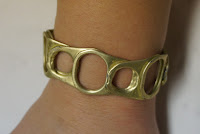 The bicycle chain ring has been sitting in my craft supply pile for many years now. I always thought to myself "that looks so cool, I want to do something really neat with it." I have also been saving some thick clear plastic from the package of a toy my daughter got for Christmas. The frame I got from SCRAP PDX for the wood part so the back was just sitting around. I threw in some rubber, my favorite material of course, and a picture of Zoe and I and had a Valentine's present for my hubby.
The bicycle chain ring has been sitting in my craft supply pile for many years now. I always thought to myself "that looks so cool, I want to do something really neat with it." I have also been saving some thick clear plastic from the package of a toy my daughter got for Christmas. The frame I got from SCRAP PDX for the wood part so the back was just sitting around. I threw in some rubber, my favorite material of course, and a picture of Zoe and I and had a Valentine's present for my hubby.Reclaimed Material: bicycle chain ring, inner tube, plastic packaging, back of picture frame
Other/New Material: tops of snaps, photograph
Tools: scissors, hand saw, epoxy, marker, clamp
 How I did it: I used the marker to mark the shape of the chain ring on the frame backing (I adjusted the back so that the stand would hold the frame up properly). The frame back was narrower than the width of the ring so it does not cover the whole back. I clamped the frame back to a table and used the hand saw to cut along the marks. I then used that as a guide to cut out the hard plastic to be used as the "glass". I did not have a piece of inner tube wide enough to cover the inner circle in the chain ring so I used the epoxy to glue two pieces together. I used the clear plastic circle as a guide to cut out the picture and rubber then cut a circle in the middle of the rubber so it could be used as the matting for the frame. I glued the picture to the back of the frame, then the rubber. I glued the clear plastic piece onto the back of the chain ring and let the pieces set. I then glued the two pieces together. I used the tops of snaps to fill in the four large holes in the chain ring.
How I did it: I used the marker to mark the shape of the chain ring on the frame backing (I adjusted the back so that the stand would hold the frame up properly). The frame back was narrower than the width of the ring so it does not cover the whole back. I clamped the frame back to a table and used the hand saw to cut along the marks. I then used that as a guide to cut out the hard plastic to be used as the "glass". I did not have a piece of inner tube wide enough to cover the inner circle in the chain ring so I used the epoxy to glue two pieces together. I used the clear plastic circle as a guide to cut out the picture and rubber then cut a circle in the middle of the rubber so it could be used as the matting for the frame. I glued the picture to the back of the frame, then the rubber. I glued the clear plastic piece onto the back of the chain ring and let the pieces set. I then glued the two pieces together. I used the tops of snaps to fill in the four large holes in the chain ring. What I would do differently: My original plan was to use snaps to attach the chain ring to the back of the frame so the picture could be changed, but the snaps were not long enough to be attached to the ring. I would like to figure out a way to make this a frame without having to use the stinky epoxy. It is a necessary evil when working with heavy duty materials.































